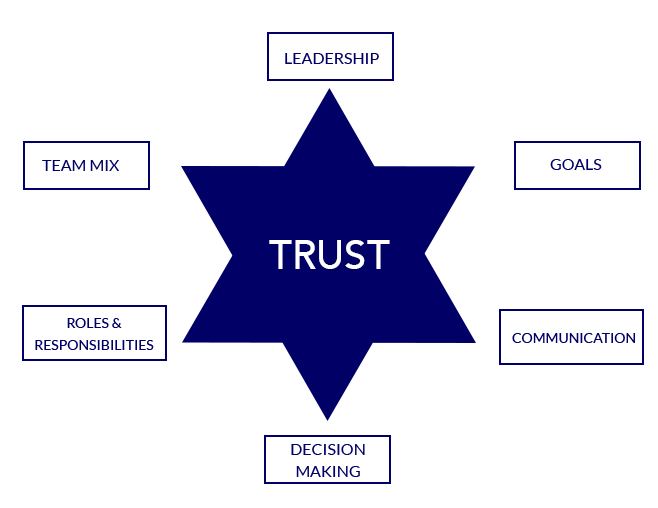Team
If you want to build a star global team, here are the seven sets of questions you should ask to make sure you are setting up your global team for success:

1. Clear goals
You may be clear about the goals of the team, but does the rest of the team understand them and buy into them? Do they understand why the goals are important? Do they have other goals they must meet beyond the global team, if they are also working for a geographic, product or functional unit? How will they trade-off their personal goals and your team goals? Does your team have more than one goal, or could your goal be interpreted in more than one way?
2. Trust
Building trust is a combination of building credibility (showing that you do as you say) and having similar values and goals. You have to build credibility over time: it is hard to build and very easy to lose. Take care in how you set expectations, because people hear what they want to hear. Have difficult conversations at the start, not the end.
Building a sense of shared values and purpose is essential, because there will always be difficult moments. At those moments of truth, you need your team to default to co-operation and support, not to mistrust and self-preservation. In practice, this means you need some shared experiences which come from spending time face to face. Global teams are not cheap: face to face time will make all the difference when it matters most. Hold a global retreat, go kayaking, invest in dinner. You are even allowed to have some fun.
3. Communications
Do you rely on email? If so, you may not destroying trust, not building it. Are there agreed protocols for when and how the team will communicate: are some team members always expected to be up in the middle of the night? Have you got the right balance between synchronous and asynchronous communications? Not everyone needs to be available all the time. Are you investing enough in face to face communication?
Are all communications going through the team leader, or have you got the right balance of whole team communication and team member to team member communication? Communications should not rely on the team leader alone.
4. Leadership
If you can lead a global team, you can lead any team. It is an outstanding development opportunity and a real challenge. As with other team members, the team leader needs:
- Curiosity: the growth mindset, being open to new ideas and learning fast
- High accountability:
- Adaptability: team leaders who believe in my way or no way will struggle. They have to be comfortable with ambiguity.
Above all, global team leaders need to master the 21st century leadership skill of influence: making things happen through people you control indirectly or not at all. Influence skills include:
- Influencing and motivating team members positively
- Influencing decision maker and partners, to align agendas and make things happen
- Influence decisions where the process may be unclear and you have low control
5. Decision making
Business is not a democracy, but each team member needs to know how decisions will be made, who makes them and how they can be involved. If decision making is not transparent then team members will assume the worst. It is not enough to make the decision: you will have to explain why the decision was made, and what the implications are. Don’t assume your team knows this: ask them to explain back to you about why a decision was made and what it implies: is their understanding the same as yours?
Does the formal decision making process work, or do you have to work back channels the whole time? Are the accountabilities for who decides what clear?
6. Right team mix
You probably are making sure that you have the right skills mix on your team. As important is to make sure you have the right values. Hire to values, not to skills: you can train skills, but you can not train values. The values which are important on a global team include:
- Curiosity and openness to new ideas, new ways of working and new cultures. Avoid people who have a fixed mindset about how things should be done.
- Comfortable with ambiguity: you need people who can adapt, and find the win win in difficult situations.
- High accountability: when there is no one looking over your shoulder it is easy to hide. You need people who you can trust to deliver when you are not there, to deal with challenges without relying on you to become available in their time zone, to take the lead and not wait for instructions.
7. Clear roles and responsibilities
Is there complete transparency about who does what? If you asked each team member what the other team members are doing, would they know? Is each person’s role and to-do list open to everyone else, or is it a closed book?

